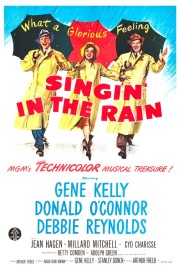Singin’ in the Rain
I’ve been trying to rewatch “Singin’ in the Rain” since Debbie Reynolds, who was 19 when she went toe-to-toe with Gene Kelly (and shined) in this film, passed away the day after her daughter, Carrie Fisher, back in December. But Netflix availability has been practically impossible since January. But it finally arrived a few weeks ago, and it’s time to catch up to the best movie musical of all-time.
When “The Artist” came out, and won Best Picture, in 2011, the only thing I could think of was how it was a riff on Stanley Donan and Gene Kelly’s masterpiece. Both films deal with the transition in Hollywood for silent films to talkies, with “The Artist” as a silent film, and “Singin’ in the Rain” as a musical comedy. While “The Artist” has its merits, however, it lacks the charm offensive of “Singin’ in the Rain.” It also lacks the authenticity. Yes, the film is a romantic fantasy from Hollywood, but because it’s from a Hollywood only two decades removed from the transition, it deals intently with it. In particular, one of the key elements of the script by Betty Comden and Adolph Green is what to do when a star’s voice doesn’t match up to their looks.
Even though I had seen the film before, it had been long enough to forget why Lina Lamont (Jean Hagen) didn’t speak for the first several minutes of the movie. She is the co-star of Kelly’s Don Lockwood, and they’re at the premiere of their latest silent hit. Don does all the talking, and when we hear Lina’s voice, we see why the studio wanted him to be the voice of the couple. Their relationship is a PR stunt by the studio, though; there’s no real emotion behind their pairing. As Don and his on-screen partner, musician Cosmo Brown (Donald O’Connor) are leaving the premiere, however, the car breaks down, and Don has to run away from some fans. He finds his way into the car of Reynolds’s Kathy Selden, a stage actress who berates Don his own abilities. When he and Lina find themselves making their first talkie after the success of “The Jazz Singer,” it’s not hard for Don to see Kathy’s point when the test screening, with Lina’s voice, and Don improvising truly appalling dialogue that is easier for him to remember, making it a laughing stock. How can they save the film, and Don’s reputation?
As co-directed by Donan (“Seven Brides for Seven Brothers,” “Charade”) and Kelly, “Singin’ in the Rain” is one of the most rapturous movie experiences ever made. Each musical number (“Gotta Dance,” “Make ’em Laugh,” which is a tour de force for O’Connor,” “Singin’ in the Rain,” and “Good Morning,” to shout out the most memorable ones) builds the film up with laughter, emotion and delight as we see the transition from one art form to another. And make no mistake, the move from silent films to talkies was like a night-and-day transition for cinema. For actors like Don, adaptation was necessary to stay relevant- the reliance on how something “looked” had to make room for how it sounded, as well; that’s why, when he asked the director if he could just say, “I love you, I love you, I love you” over and over again while they make their first talkie, it was a laughable moment for an audience that would have otherwise swooned during a silent film. And when Don, Kathy and Cosmo decide to replace Lina’s voice with Kathy’s to save the picture, it seems silly, although it was culled from one of the transitions from the silent age, and it causes a dilemma that will play out as one of the central plot points in the film. How it plays out is one of the great, delightful finales in all of movies, as this one will give you a wonderful feeling of being as happy as you may have been when, like Don with Kathy, you fall in love for the first time. Revisiting any great film can do that. Revisiting this great film assures it.










